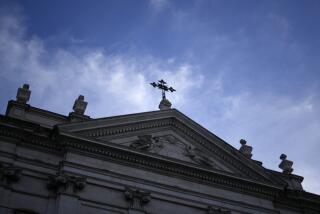Archive: Jonestown’s Lessons Still Go Unheeded
It was deja vu: Too many bodies, life snuffed out, arranged neatly in restful repose, showing no obvious signs of violence. In one case, the dead were shielded from the sun by the red-tiled roof of a million-dollar mansion in a wealthy Southern California enclave. In the other, they lay bloated around a tin-roofed pavilion in the jungle of a deeply impoverished South American country.
But the death rituals of Peoples Temple and Heaven’s Gate--separated by nearly two decades and thousands of miles--will be linked forever.
Although other mass suicides have jolted the world in recent years, the discovery Wednesday afternoon of 39 bodies in Rancho Santa Fe harks back like no other to the worst such event in modern times: the deaths of the Rev. Jim Jones and 912 followers in Guyana.
These distinctly American tragedies underscore the unspeakable carnage that can flow from the surrender of individual wills to the twisted demands of a doomsday cult. And this week’s tragedy--like those in the intervening years--demonstrates that the profound lessons of Jonestown have gone unheeded.
“I think people should have learned something from Jonestown--but they haven’t learned a damn thing,” said Fred Lewis, who lost 27 relatives, including his wife and seven children.
While much about the cyberspace-based cult remains unknown, initial reports indicate there are not only some striking contrasts to Peoples Temple but also similar dynamics that bound the members to the groups for life--and into death.
On the surface, the Heaven’s Gate group appeared monastic and reclusive. The members of the sect wore dark clothing, shaved their heads and interacted only minimally with outsiders while building a computer programming business.
But Peoples Temple bordered on becoming a social movement. With thousands of members in California, Jones sought the limelight, winning public appointments, putting his troops on the streets for demonstrations, wooing politicians from the mayor of San Francisco to future First Lady Rosalynn Carter.
Contrary to widespread belief that cults only attract the ignorant and confused, both organizations appeared to draw a number of highly competent people of various ages and colors. And this enabled them to build successful economic bases.
While members of Heaven’s Gate were paid to create World Wide Web sites for clients on the Internet, Temple members held high-profile positions with the district attorney and the local welfare department, ran homes for the elderly and took in foster children.
The Temple wound up with about $10 million in assets, most from members who signed over everything they owned. The resources of Heaven’s Gate were sufficient for the group to operate in three states and to lease the 10-bedroom estate in Rancho Santa Fe.
Each group spoke to the outside world using the most effective instrument available. The Temple made promotional films and had its own widely distributed newspaper; Heaven’s Gate established its own site in cyberspace.
Using biblical metaphors, the leaders of each of the groups fostered feelings that the members were special--Jones’ minions were the Chosen People, Heaven’s Gate’s were Angels.
And each group believed in life after death. The followers of the computer cult believed that a UFO would whisk them to another place. “The other side,” Jones called it.
Both leaders were called “Father.” And their followers were subject to controls that went so far as to dictate sexual practices. Heaven’s Gate members were required to be celibate; Temple mores were whatever Jones wanted at the time.
Each group harbored a dark side--the concept of mass suicide. In his paranoid rantings, Jones conducted rehearsals in California, and later in Guyana after news media revelations and other pressures forced his retreat to the church’s agricultural commune there.
After the Jonestown tragedy, information emerged that many of the victims were murdered. Dozens of adults were forcibly injected or shot, and hundreds of children were killed.
Heaven’s Gate at least hinted that members planned to kill themselves to rendezvous, they believed, with a UFO approaching Earth from behind the Hale-Bopp comet.
Whether government agencies were aware of this is unclear. But Dr. Chris Hatcher, a San Francisco psychologist who has worked with former cult members, said anti-cult groups were not cognizant of the danger.
“There’s a misperception that this group was on the radar screen of people who are concerned about violent cults,” he said. “They were not.”
By contrast, law enforcement agencies and the U.S. State Department were long aware of allegations that Jones had threatened mass suicide but apparently did not take the threat seriously. The Federal Communications Commission, which was monitoring Peoples Temple radio transmissions from Guyana, once even recorded a discussion about a mass suicide rehearsal.
“When is the government going to do something to protect people from this sort of tragedy,” said Clare Bouquet of Burlingame, who called on government agencies for help before her son Brian perished in Jonestown.
In the computer-filled Rancho Santa Fe house, the 39 apparently perished from overdoses of sleeping pills, their bodies shrouded in purple triangles of cloth. For the most part, the Jonestown inhabitants died from a purple cyanide-laced fruit punch--not far from a sign:
“Those who do not remember the past are condemned to repeat it.”
Tim Reiterman investigated Peoples Temple for 1 1/2 years as a San Francisco Examiner reporter, and one of his stories led Rep. Leo Ryan to conduct a fact-finding mission to Jonestown in November 1978. Ryan was shot to death in an airport ambush there, along with three newsmen and a Temple defector. Reiterman was wounded and later wrote a history of the Temple
More to Read
Start your day right
Sign up for Essential California for news, features and recommendations from the L.A. Times and beyond in your inbox six days a week.
You may occasionally receive promotional content from the Los Angeles Times.






